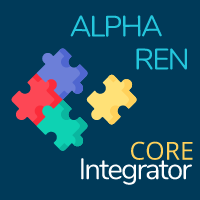 ALPHAREN CORE-Integrator (ARINT) System
ALPHAREN CORE-Integrator (ARINT) System
(c) 2021 RENware Software Systems. RESTRICTED only for project internal use
Core-Integrator System Overview
Table of contents:
What is ARINT Core
ALPHAREN Core Integrator (aka ARINT or arint) system is a framework product for automation, integration and interoperability between distributed systems or data sources, basically aimed to build API oriented, middleware, frontend and backend applications.
Practically it allows to create small-footprint and focused business oriented microservices or to transform "monolith" applications to micro-applications that will act as a single one application but with a high degree of maintainability.
Product is available as distinct software or as ready to run appliance (including also some built-in components such as an internal database for business operations).
ARINT as Service bus
ARINT acts as a high level Service BUS (ie, ESB or ESOA) to connect different micro-services and to make them to work as one. As example it is already used by all RENware Software Systems products. Of course it can be used for CUSTOMER SYSTEMS and SERVICES too.
ARINT generic process flow is:
graph TD
SRV[[Service]]
RSRV[[Repetitive \n Service]]
EXT((External system))
INCH([IN channel])
EDB[(external \n databases)]
IDB[(own internal \n database)]
OUTCH([OUT \n channel])
CALLBCK([callback endpoint])
LOGFILE[(actions \n log file)]
EXT -->|call| INCH
INCH --> SRV
INCH --> RSRV
SRV --> OUTCH
RSRV --> OUTCH
OUTCH <-.-> EDB
OUTCH <--> IDB
OUTCH --> |notify| CALLBCK
OUTCH --> |logging \n actions| LOGFILERemarks to diagram
- the
IN channelestablish the way to address the ARINT system (how to call it) - the
IN channelestablish the security rules in calling the ARINT system (authemtication) - a
Repetitive Serviceis normally called once (ie, to start it) and it begins to repeat operations (in background) at defined time intervals and for a defined period (or indefinitely)
Availability and system "presence"
-
ANYWHERE. can work even the systems that must be integrated are in different non routable LANs (address systems at
httpprotocol level) -
ANYHOW. is agnostic to format, composition, structure, encoding of information required / provided by systems that must be integrated
-
ANYTIME. can work as a distributed high scalable cluster of "ALPHA-REN Integrator Machines"
-
SECURED. can work with any public standard (ie, defined at least as
RFC) of Internet security
Each ARINT system can run: * on premises or in cloud, * deployed as classic software or Docker application container, Kubernetes node / container or * as any general containerization "standard" method
Features
Typical use cases
ALPHAREN CORE-Integrator is used for enterprise, business integrations, data science, IoT and other scenarios that require integrations of multiple systems.
Real-world, production ALPHAREN CORE-Integrator environments include:
-
A platform for processing payments from consumer devices
-
A system for a telecom operators integrating CRM, ERP, Billing and other systems as well as applications of the operator’s external partners
-
A data science system for processing of information related to securities transactions (FIX)
-
A platform for public administration systems, helping achieve healthcare data interoperability through the integration of independent data sources, databases and health information exchanges (HIE)
-
A global IoT platform integrating medical devices
-
A platform to process events produced by early warning systems, (ex SAP EWS)
-
Backend e-commerce systems managing multiple suppliers, marketplaces and process flows B2B platforms to accept and process multi-channel orders in cooperation with backend ERP and CRM systems
-
Platforms integrating real-estate applications, collecting data from independent data sources to present unified APIs to internal and external applications
-
A system for the management of hardware resources of an enterprise cloud provider
-
Online auction sites
-
E-learning platforms
-
Ad-hoc data API for databases for example to protect them to direct access or to hide particular implementation details (especially in legacy old databases) allowing for a smooth and transparent transition to new redesigned implementations